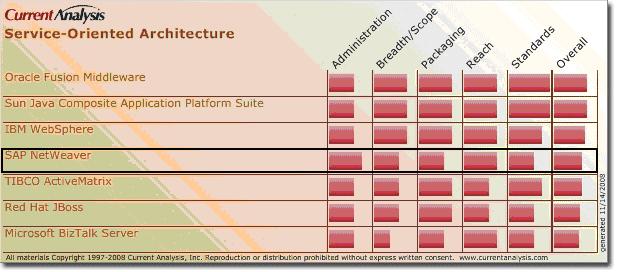With my concentration diverting towards various SOA players in market, I thought about analyzing them a bit. And was sure at that point that internet search (trusting Web 2.0 capabilities) will make it fast. But then a quote made me reluctant to do so. Henri Frederic Amiel said "Analysis kills spontaneity. The grain once ground into flour springs and germinates no more." I really don't intend to kill the spontaneity of SOA key players :). So I followed a different quote "When a truth is necessary, the reason for it can be found by analysis, that is, by resolving it into simpler ideas and truths until the primary ones are reached." - By Gottfried Leibniz. I found a graphical representation comparing various leading industry shapers:
By Current Analysis
What is in there?
Initially I was a bit discouraged by SAP NetWeaver comparisons with other technologies. But then I thought about the factors and assessment parameters based on which the comparisons were made and where exactly SAP stands. Let's see how exactly SAP provides the solution for various assessment parameters:
Administration: As it could be noticed, SAP is far ahead any of its competitors on the Administration levels. Solution Manager provides the Business Process Monitoring capabilities for core business processes. It acts as a central monitoring infrastructure for an entire landscape from application as well as technology perspective. The inherent administration capabilities of NetWeaver using NetWeaver Administrator (nwa) have also provided a handy Admin tool to the Basis administrators. The underlying support for Abap as well as Java provides wide range of support for customized administration options.
Breadth: The context of Breadth here refers to interoperability of SAP NetWeaver with other SOA suits. This is the area where I couldn't find much development recently. In my opinion, once we have an entire landscape standardized with Enterprise Service Repository as the platform to manage all the services, the interoperability task would reduce considerably. However, there must be a strategy defined for any future transitions.
Packaging: It refers to the industry specific packages provided as a part of SOA suite. SAP already has a strong industry knowledge base and long back initiated the collaboration with various partners and customers to create the
ES Community. One of the major outputs of this collaboration would turn out as set of Integration Scenarios specific to various business processes termed as
Enterprise Service Bundles. SAP even has plans to certify these Service Bundles based on defined standards. I would say that if not at present, in future the Packaging capabilities provided by SAP would outperform any of its rivals.
Reach: This incorporates the capability of an individual Suite to reach their perspective clients and deliver the solution. SAP is already a market leader for its strong client base. To increase the reach further SAP came up with the EcoHub initiative.
Standards: SAP NetWeaver based SOA implementation called as Enterprise Service Architecture (ESA) has Enterprise Services as its base. These services are technically web services which are SOAP based with underlying xml support. They are stored inside ESR and Service Registry which is UDDI v.3 compliant. All SAP and non-SAP systems related communications could be handled using SAP Process Integration (PI) which ensures the use of open standards like wsdl, xsd, dtd, bpel, soap etc.
What stay hidden?
There were many points covered for the comparisons made above. In order to gain improvements on any of these factors above, what exactly an SOA suite should concentrate on? The answer to this would surely be SOA Governance. For an organization, SOA Governance steers the implementation of SOA based on policies and control mechanisms. The administration features of SAP mentioned above forms a base for SAP's answer to SOA Governance.
The Gartner's Magic Quadrant (As of 4Q07) for SOA Governance capabilities of various SOA suites shows SAP as a rising Visionary and Amberpoint as one of the market Leaders. SAP collaborates its capabilities with established leaders like Amberpoint which would provides an edge over the opponents.
What is not present?
Apart from various important factors discussed above, in my opinion another assessment factor could be - How much an SOA Suite concentrates on Innovation? The EcoHub initiative by SAP mentioned above is already providing a helping hand to bring up best solution practices based on business experiences of SAP and its partners. Another proposal is SAP InnoCentive which target inventive methodologies. Not only does it capture pioneering solutions but existing critical challenges could also be discussed to be solved in effective ways.
"This analysis increases the significance of earlier findings and highlights the continuing concerns with these facilities" 🙂 - Caroline Steinberg.
